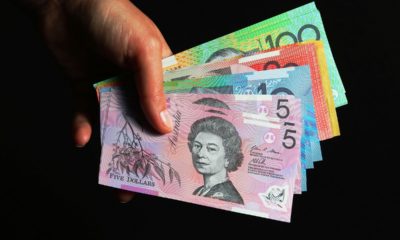Stock markets are bouncing back on Friday, although I don’t think anyone is getting excited by the moves which pale in comparison to the losses that preceded them.
This looks like nothing more than a dead cat bounce after a steep decline over the last couple of weeks as investors have been forced to once again accept that interest rates are going to rise further and faster than hoped.
Double-digit eurozone inflation
Inflation in the eurozone hit 10% in September ahead of schedule, with markets expecting a jump to 9.7% from 9.1% in August. In normal circumstances that may have triggered a reaction but these are anything but normal. Markets are still pricing in a more than 70% chance of a 75 basis point rate hike from the ECB next month with an outside chance of 1%. The euro is slightly lower following the release which also showed core inflation rising a little higher than expected to 4.8%.
Sterling recovers as the UK is revised out of a potential recession
We’re seeing the third day of gains for the pound which has now recovered the bulk of the losses sustained after the “mini-budget” a week ago. This is not a sign of investors coming around the new Chancellor’s unfunded tax-cutting, but rather a reflection of the work done since to calm the market reaction. That includes the emergency intervention from the BoE, talk of measures to balance the cost of the tax cuts, reported discussions with the OBR and rumoured unrest within the Tory party. We’ll have to see what that amounts to and sterling could certainly react negatively again to inaction or the wrong action.
GDP data this morning brought some good news, although as far as positive updates go, this is surely towards the more insignificant end. The UK is not in recession after the second quarter GDP was revised up from -0.1% to +0.2%. While all positive revisions are welcome, the technical recession wasn’t really significant in the first place. The important thing was that the UK is struggling to grow and facing a probable deeper recession down the road and today’s revision doesn’t change that.
Disappointing Chinese surveys
China’s PMIs highlighted the widening gulf between the performance of state-owned firms versus their private competition. It goes without saying that being backed by the state in uncertain times like this carries certain advantages and that has been evident for some time.
Private firms have been more sensitive to Covid restrictions and have therefore been heavily hampered this year. Still, even with those state-backed benefits, the headline PMI was far from encouraging rising to 50.1 and barely in growth territory. With the non-manufacturing PMI also slipping from 52.6 to 50.6, it’s clear that the economy still faces enormous headwinds and the global economy stalling around it will only add to them.
BoJ ramps up bond purchases amid higher yields
The Bank of Japan ramped up bond purchases overnight as it continues to defend its yield curve control thresholds in volatile market conditions. Rising global yields have forced the central bank to repeatedly purchase JGBs in order to maintain its target. There has been a growing expectation that the BoJ could tweak its 0% target or widen the band it allows fluctuations between in order to ease the pressure on the currency but that’s not been forthcoming, with the MoF instead intervening in the markets for the first time since 1998. The intervention doom loop continues.
RBI rate hike and credit line
The Reserve Bank of India hiked the repo rate by 50bps to 5.9% on Friday, in what will likely be one of its final tightening measures in the fight against inflation. The decision was widely expected and followed shortly after by guidance to state-run refiners to reduce dollar buying in spot markets through the use of a $9 billion credit line. The strength of the dollar is posing a risk to countries around the world, as we’ve seen very clearly in recent weeks as mentioned above, and measures like this will seek to alleviate those pressures. Much more will be needed to make any significant difference though.
Oil edges higher into the weekend
Oil prices are rising again as we head into the weekend, with the focus now on the OPEC+ next week. There’s been plenty of rumours about how the alliance will respond to the deteriorating economic outlook and lower prices. A sizeable cut now looks on the cards, the question is whether it will be large enough to offset the demand destruction caused by the impending economic downturn. Not to mention how any cut would work considering the shortfall in output targets throughout this year.
Brent continues to trade around the March to August lows having traded below here over the last week amid recession fear in the markets. We’re now seeing some resistance around $88, perhaps a sign that traders don’t believe OPEC+ will deliver a large enough cut to make a significant difference.
Encouraging but maybe not sustainable
Gold is making gains for a fourth consecutive day after a difficult start to the week. While the recovery has been encouraging, it’s hard to imagine it building on it in any significant way as that would probably require rate expectations to have peaked and inflation perhaps to have as well. While that may be the case, it’s hard to imagine pressure easing from here which may maintain pressure on the yellow metal for a little longer yet.
Key resistance to the upside lies around $1,680 and $1,700, with $1,620 and $1,600 below being of interest.
A period of stability is what bitcoin needs
It’s been a very choppy week in bitcoin which has failed to make a sustainable run in either direction despite attempts at both. Perhaps we are seeing a floor forming a little shy of the early summer lows around $17,500, although that will very much depend on risk appetite not plummeting once more which it very much has the potential to do. I keep using the word resilience when discussing bitcoin and that has very much remained the case. It did also struggle to build on the rally earlier this week, even hold it into the end of the day, so perhaps a period of stability is what it needs.


 Billionaire Watch3 weeks ago
Billionaire Watch3 weeks ago
 Startups4 weeks ago
Startups4 weeks ago
 News4 weeks ago
News4 weeks ago
 News4 weeks ago
News4 weeks ago
 Bitcoin4 weeks ago
Bitcoin4 weeks ago
 Naira4 weeks ago
Naira4 weeks ago
 Forex3 weeks ago
Forex3 weeks ago
 Treasury Bills4 weeks ago
Treasury Bills4 weeks ago


























